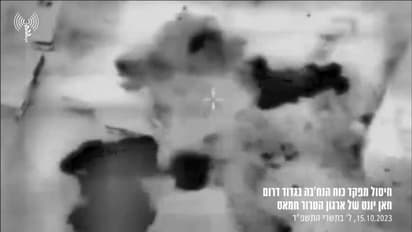Israel-Palestine war: Top Hamas group commander behind infiltration killed in airstrike | WATCH

Synopsis
The Israeli airstrike did not only target Al Kedra but also led to the elimination of several other Hamas and Islamic Jihad terror operatives. The Israeli forces executed airstrikes on more than 100 military targets in various locations, including Zaytun, Khan Yunis, and west Jabaliya.
In a recent development, Israeli airstrikes have reportedly targeted and killed Billal Al Kedra, a top Hamas commander responsible for the Kibbutz Nirim massacre in Israel. The Israel Air Force (IAF) revealed this operation, citing Israeli intelligence pinpointing Al Kedra's location in Khan Yunis, a city in the southern part of the Gaza Strip.
Billal Al Kedra served as the commander of the Nukhba force, a naval commando unit within Hamas' special forces unit known as the Izz ad-Din al-Qassam Brigades.
The Israeli airstrike did not only target Al Kedra but also led to the elimination of several other Hamas and Islamic Jihad terror operatives. The Israeli forces executed airstrikes on more than 100 military targets in various locations, including Zaytun, Khan Yunis, and west Jabaliya.
These strikes focused on dismantling Hamas operational command centers and military compounds. Additionally, anti-tank missile launch pads and observation posts were effectively neutralized.
The background of this operation is connected to a daring assault launched by Hamas operatives on Israel last week, involving land-sea-air infiltration. These operatives utilized motorized gliders, boats, and on-foot approaches to infiltrate Israel's borders.
The Kibbutz Nirim, located in close proximity to the Gaza border, was among the targets where Hamas carried out a massacre. Residents of Nirim and similar small agricultural communities along the border have been subjected to continuous rocket fire from Hamas, compelling them to frequently seek refuge in fortified safe rooms.
This defensive strategy has become necessary since Hamas gained control of Gaza in 2005 after the unilateral withdrawal of the United States from the Palestinian enclave.
Check the Breaking News Today and Latest News from across India and around the world. Stay updated with the latest World News and global developments from politics to economy and current affairs. Get in-depth coverage of China News, Europe News, Pakistan News, and South Asia News, along with top headlines from the UK and US. Follow expert analysis, international trends, and breaking updates from around the globe. Download the Asianet News Official App from the Android Play Store and iPhone App Store for accurate and timely news updates anytime, anywhere.